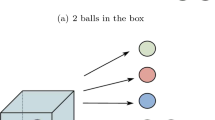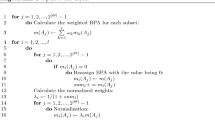Abstract
Dempster-Shafer evidence theory (D-S theory) is applied to process uncertain information in different scenarios. However, traditional Dempster combination rule may produce counterintuitive results while dealing with highly conflicting data. Inspired by a perspective of constructing base belief function for conflicting data processing in D-S theory, a new base basic probability assignment (bBPA) method is proposed to process the potential conflict before data fusion. Instead of assigning initial belief on the whole power set space, the new method assigns the base belief to basic events in the frame of discernment. Consequently, the bBPA is consistent with the classical probability theory. Several numerical examples are adopted to verify the reliability and accuracy of the method in processing highly conflicting data. The data sets in the University of California Irvine (UCI) Machine Learning Repository are used to verity the availability of the new method in classification problem. Experimental result shows that the new method has some superiority in dealing with highly conflicting data.









Similar content being viewed by others
Explore related subjects
Discover the latest articles and news from researchers in related subjects, suggested using machine learning.References
Dempster AP (1967) Upper and lower probabilities induced by a multi-valued mapping. Ann Math Stat 38(2):325–339
Shafer G (1976) A mathematical theory of evidence. Princeton University Press, Princeton
Liu Z-G, Pan Q, Dezert J, Mercier G (2017) Hybrid classification system for uncertain data. IEEE Trans Syst Man Cybern Syst 47(10):2783–2790
Liu Z-G, Liu Y, Dezert J, Cuzzolin F (2020) Evidence combination based on credal belief redistribution for pattern classification. IEEE Trans Fuzzy Syst 28(4):618–631
Su Z-G, Denoeux T (2018) BPEC: Belief-peaks evidential clustering. IEEE Trans Fuzzy Syst 27(1):111–123
Zhou K, Martin A, Pan Q, Liu Z (2018) SELP: Semi–supervised evidential label propagation algorithm for graph data clustering. Int J Approx Reason 92:139–154
Meng J, Fu D, Tang Yongchuan (2020) Belief-peaks clustering based on fuzzy label propagation. Appl Intell 50(4):1259–1271
Jiang H, Wang R, Gao Z, Gao J, Wang H (2019) Classification of weld defects based on the analytical hierarchy process and dempster–shafer evidence theory. J Intell Manuf 30(4):2013–2024
Wang Z, Wang R, Gao J, Gao Z, Liang Y (2020) Fault recognition using an ensemble classifier based on dempster–shafer theory. Pattern Recogn 99:107079
Murphy CK (2000) Combining belief functions when evidence conflicts. Decis Support Syst 29 (1):1–9
Denoeux T, Younes Z, Abdallah F (2010) Representing uncertainty on set-valued variables using belief functions. Artif Intell 174(7):479–499
Wang J, Hu Y, Xiao F, Deng X, Deng Y (2016) A novel method to use fuzzy soft sets in decision making based on ambiguity measure and dempster–shafer theory of evidence: an application in medical diagnosis. Artif Intell Med 69:1–11
Seiti H, Hafezalkotob A (2018) Developing pessimistic–optimistic risk-based methods for multi-sensor fusion An interval-valued evidence theory approach. Appl Soft Comput 72:609–623
Fu C, Chang W, Yang S (2020) Multiple criteria group decision making based on group satisfaction, vol 518
Fei L, Deng Y, Hu Y (2019) Ds-vikor: A new multi-criteria decision-making method for supplier selection. Int J Fuzzy Syst 21(1):157–175
Shi H, Wang L, Li X-Y, Liu H-C (2019) A novel method for failure mode and effects analysis using fuzzy evidential reasoning and fuzzy petri nets. J Ambient Intell Human Comput:1–15
Jiang W, Xie C, Zhuang M, Tang Y (2017) Failure mode and effects analysis based on a novel fuzzy evidential method. Appl Soft Comput 57:672–683
Zhang X, Mahadevan S, Deng X (2017) Reliability analysis with linguistic data: an evidential network approach. Reliab Eng Syst Safety 162:111–121
Song Y, Wang X, Zhu J, Lei L (2018) Sensor dynamic reliability evaluation based on evidence theory and intuitionistic fuzzy sets. Appl Intell 48(11):3950–3962
Xu X, Xu W, Xu D, Xu H, Hu Y, Li J (2020) Evidence updating with static and dynamical performance analyses for industrial alarm system design. ISA Trans 99:110–122
Zhang J, Deng Y (2017) A method to determine basic probability assignment in the open world and its application in data fusion and classification. Appl Intell 46(4):934–951
Zhang W, Deng Y (2019) Combining conflicting evidence using the dematel method. Soft Comput 23(17):8207–8216
Song Y, Wang X, Wu W, Quan W, Huang W (2018) Evidence combination based on credibility and non-specificity. Pattern Anal Appl 21(1):167–180
Xiao F (2019) A multiple-criteria decision-making method based on d numbers and belief entropy. Int J Fuzzy Syst 21(4):1144–1153
Deng X, Jiang W (2018) An evidential axiomatic design approach for decision making using the evaluation of belief structure satisfaction to uncertain target values. Int J Intell Syst 33(1):15–32
Jiang W, Huang C, Deng X (2019) A new probability transformation method based on a correlation coefficient of belief functions. Int J Intell Syst 34(6):1337–1347
Montes I, Miranda E, Vicig P (2019) Outer approximating coherent lower probabilities with belief functions. Int J Approx Reason 110:1–30
Yi Y, Han D, Dezert J (2019) Basic belief assignment approximations using degree of non-redundancy for focal element. Chin J Aeronaut 32(11):2503–2515
Jiang W (2018) A correlation coefficient for belief functions. Int J Approx Reason 103:94–106
Deng Y (2016) Deng entropy. Chaos Solitons Fract 91:549–553
Jiroušek R, Shenoy PP (2018) A new definition of entropy of belief functions in the dempster–shafer theory. Int J Approx Reason 92:49–65
Wu D, Tang Y (2020) An improved failure mode and effects analysis method based on uncertainty measure in the evidence theory. Qual Reliab Eng Int 36(5):1786–1807
Martin A (2012) About conflict in the theory of belief functions. In: Belief Functions: Theory and Applications. Springer, pp 161–168
Pichon F, Destercke S, Burger T (2014) A consistency-specificity trade-off to select source behavior in information fusion. IEEE Trans Cybern 45(4):598–609
Deng Y (2015) Generalized evidence theory. Appl Intell 43(3):530–543
Jiang W, Zhan J (2017) A modified combination rule in generalized evidence theory. Appl Intell 46(3):630–640
Su X, Li L, Qian H, Mahadevan S, Deng Y (2019) A new rule to combine dependent bodies of evidence. Soft Comput 23(20):9793–9799
Martin A (2019) Conflict management in information fusion with belief functions. In: Information Quality in Information Fusion and Decision Making. Springer, pp 79–97
Xiao F (2019) Multi-sensor data fusion based on the belief divergence measure of evidences and the belief entropy. Inf Fusion 46:23–32
Yang J-B, Xu D-L (2013) Evidential reasoning rule for evidence combination. Artif Intell 205:1–29
Xu X, Zhang D, Yu B, Chang L, Li J (2020) Evidence reasoning rule-based classifier with uncertainty quantification. Inf Sci 516:192–204
Fu C, Hou B, Chang W, Feng N, Yang S (2020) Comparison of Evidential Reasoning Algorithm with Linear Combination in Decision Making, vol 22
Zhang M-J, Wang Y-M, Li L-H, Chen S-Q (2017) A general evidential reasoning algorithm for multi-attribute decision analysis under interval uncertainty. Eur J Oper Res 257(3):1005–1015
Mi Z, Liu X, Yang J (2017) Evidential reasoning approach for MADM based on incomplete interval value. J Intell Fuzzy Syst 33(6):3707–3721
Chen S, Wang Y, Shi H, Zhang M, Yang Lin. (2018) Evidential reasoning with discrete belief structures. Inf Fus 41:91–104
Du Y-W, Wang Y-M, Qin M (2018) New evidential reasoning rule with both weight and reliability for evidence combination. Comput Ind Eng 124:493–508
Chen S-M, Cheng S-H, Chiou C-H (2016) Fuzzy multiattribute group decision making based on intuitionistic fuzzy sets and evidential reasoning methodology. Inf Fusion 27:215–227
Liu Z-G, Pan Q, Dezert J, Martin A (2018) Combination of Classifiers With Optimal Weight Based on Evidential Reasoning. IEEE Trans Fuzzy Syst 26(3):1217–1230
Zhao F-J, Zhou Z-J, Hu C-H, Chang L-L, Zhou Z-G, Li G-L (2018) A New Evidential Reasoning-Based Method for Online Safety Assessment of Complex Systems. IEEE Trans Syst Man Cybern-Syst 48(6):954–966
Yang Y, Xu D-L, Yang J-B, Chen Y-W (2018) An evidential reasoning-based decision support system for handling customer complaints in mobile telecommunications. Knowl-Based Syst 162(SI):202–210
Wang Y, Zhang K, Deng Y (2019) Base belief function: an efficient method of conflict management. J Ambient Intell Human Comput 10(9):3427–3437
Zadeh LA (1986) A simple view of the dempster-shafer theory of evidence and its implication for the rule of combination. AI Mag 7(2):85–85
Zadeh LA, Klir GJ, Bo Y (1996) Fuzzy sets, fuzzy logic, and fuzzy systems: selected papers, vol 6. World Scientific
Author information
Authors and Affiliations
Corresponding author
Additional information
Publisher’s note
Springer Nature remains neutral with regard to jurisdictional claims in published maps and institutional affiliations.
The work is partially supported by National Key Research and Development Project of China (Grant No. 2019YFB2102602).
Rights and permissions
About this article
Cite this article
Jing, M., Tang, Y. A new base basic probability assignment approach for conflict data fusion in the evidence theory. Appl Intell 51, 1056–1068 (2021). https://doi.org/10.1007/s10489-020-01876-0
Published:
Issue Date:
DOI: https://doi.org/10.1007/s10489-020-01876-0
Keywords
Profiles
- Ming Jing View author profile
- Yongchuan Tang View author profile




